



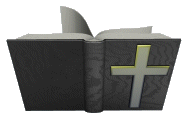


Formal Equivalent or “Word for Word”
These translations attempt to reproduce the Greek and Hebrew as exactly as possible into English. Words, figures of speech, and sometimes even the sentence structure of the original languages are reproduced in a much more limited way in this type of Bible. These hold -in varying degrees- to a generally word for word approach. However anyone who knows more than one language recognizes that an exact word-for-word translation is simply not possible if one is going to communicate in an understandable way in the english language.
Dynamic Equivalent or “Thought for Thought”
These Bibles run on a more thought-for-thought philosophy than the Word-for-Word translations. Greek and Hebrew figures of speech are replaced with modern rough equivalents. The intent of the translator in this type of translation is to bring the meaning of the text out in an easier to read format. The translations in this category essentially take each portion of the text and reword it to better convey the meaning of the original writer.
Paraphrase
These are not really translations, but rewordings of the Scriptures that speak in a very earthy, common tongue. Those who advocate these note that the New Testament was written in the common language of the people and not that of playwrights or philosophers. The results can be the clearest expression of Scripture on par with the original. However, theological biases can creep in and be readily apparent. These are acceptable for devotional reading, but even the authors themselves would not suggest using them for study or as a church Bible. Some paraphrases are based on the original languages, while others on translations themselves. "There are dangers in paraphrases, as well as values. There is a possibility that the translator, may twist the scriptures to fit his beliefs instead of what the original writer meant to say."
These translations attempt to reproduce the Greek and Hebrew as exactly as possible into English. Words, figures of speech, and sometimes even the sentence structure of the original languages are reproduced in a much more limited way in this type of Bible. These hold -in varying degrees- to a generally word for word approach. However anyone who knows more than one language recognizes that an exact word-for-word translation is simply not possible if one is going to communicate in an understandable way in the english language.
Dynamic Equivalent or “Thought for Thought”
These Bibles run on a more thought-for-thought philosophy than the Word-for-Word translations. Greek and Hebrew figures of speech are replaced with modern rough equivalents. The intent of the translator in this type of translation is to bring the meaning of the text out in an easier to read format. The translations in this category essentially take each portion of the text and reword it to better convey the meaning of the original writer.
Paraphrase
These are not really translations, but rewordings of the Scriptures that speak in a very earthy, common tongue. Those who advocate these note that the New Testament was written in the common language of the people and not that of playwrights or philosophers. The results can be the clearest expression of Scripture on par with the original. However, theological biases can creep in and be readily apparent. These are acceptable for devotional reading, but even the authors themselves would not suggest using them for study or as a church Bible. Some paraphrases are based on the original languages, while others on translations themselves. "There are dangers in paraphrases, as well as values. There is a possibility that the translator, may twist the scriptures to fit his beliefs instead of what the original writer meant to say."
| Bible Translation Dates and Number of Translators | ||
| Amplified | 1965 | 1 (Frances Stewert) |
| ASV (American Standard Version) | 1901 | 30 |
| CEB (Common English Bible) | 2011 | 120 |
| CEV (Contempory English Version) | 1995 | 100 |
| ESV (English Standard Version) | 2001 | 100 |
| ERV (Easy-to-Read Version) | 1987 | 5 |
| Geneva | 1560 | 14 |
| God’s Word | 1995 | 26 |
| HCSB (Holman Christian Standard Bible) | 2000 | 90 |
| ISV (International Standard Version) | 2011 | 7 |
| KJV (King James Version) | 1611 | 50 |
| LB (Living Bible) | 1971 | 1 (Kenneth Taylor) |
| LEB (Lexham English Bible) | 2012 | 14 |
| Message | 2001 | 1 (Eugene Peterson) |
| MEV (Modern English Version) | 2012 | 47 |
| NAB (New American Bible) | 1970 | 6+ |
| NASB (New American Standard Bible) | 1971 | 39 |
| NASU (New American Standard Updated) | 1995 | 39 original + “revisers” |
| NEB (New English Bible) | 1970 | 26 |
| NET (New English Translation) | 2005 | 23+ |
| NCV (New Century Version) | 1991 | 50 |
| NIV (New International Version) | 1978 | 110 |
| NIV2011 (New International Version) Update | 2011 | 15 |
| NKJV (New King James Version) | 1982 | 130 |
| NLT (New Living Translation) | 1996 | 99 |
| NRSV (New Revised Standard Version) | 1989 | 30 |
| REB (Revised English Bible) | 1989 | 26 |
| RSV (Revised Standard Version) | 1952 | 32 |
| TEV (Today’s English Version) | 1976 | 7 |
| TNIV (Today’s New International Version) | 2002 | 13 |
| The Voice | 2009 | 27 |
| Reading Level and Additional Information of Different Bible Versions | |
| Geneva Bible Published: 1560 (revised 1599) Reading Level: 12th Grade Translators: Calvinist |
King James Version Published: 1611 (revised 1769) Reading Level: 12th Grade Translators: Anglican |
| Revised Version Published: 1885 Reading Level: 12th grade Translators: Mainline/British, conservative |
American Standard Version Published: 1901 Reading Level: 12th grade Translators: Mainline/Unitarian, conservative |
| Revised Standard Version Published: 1952 (revised 1971) Reading Level: 10th Grade Translators: Mainline/Catholic, somewhat liberal |
New World Translation Published: 1961 (revised 1984) Translators: The Watch Tower Bible and Tract Society (aka Jehovah's Witnesses) |
| New American Bible Published: 1970 (NT, Psalms revised 1996) Translators: Catholic, moderate Reading Level: 9th Grade |
The Living Bible Published: 1971 Reading Level: 4th Grade Translators: Kenneth Taylor (a Baptist) |
| New American Standard Bible Published: 1971 (revised 1977, 1995) Translators: Evangelical, Conservative Reading Level: 11th Grade |
Good News Translation (Formerly Today's English Version) Published: 1976 (revised 1992) Reading Level: 8th Grade Translators: Evangelical moderate, Catholic |
| New International Version (1984) Published: 1978 (revised 1984) Reading Level: 8th Grade Translators: Evangelical, conservative |
New International Version (2011) Published: 2011 Reading Level: 8th Grade Translators: Evangelical, slightly conservative |
| New King James Version Published: 1982 Reading Level: 9th Grade Translators: Evangelical/Fundamental, conservative |
Revised English Bible Published: 1989 Reading Level: 10th Grade Translators: Mostly Liberal British Protestant/Catholic |
| New Revised Standard Version Published: 1990 Reading Level: 10th Grade Translators: Mainline/Catholic/Orthodox, somewhat liberal |
New Living Translation Published: 1996 (revised 2004) Reading Level: 6th Grade Translators: Evangelical, conservative |
| English Standard Version Published: 2001 Reading Level: 10th Grade Translators: Evangelical, conservative |
Today's New International Version Published: 2005 Reading Level: 8th Grade Translators: Evangelical, slightly conservative |
| The Message Published: 2002 (whole Bible) Reading Level: 3rd Grade Translators: Eugene Peterson (an evangelical Presbyterian) |
|
Facts About The King James Version. There were three overhauls of the KJV up through 1769, involving more than 100,000 changes (the vast majority of which merely spelling updates). The original KJV had approximately 8000 marginal notes, though these have been stripped out in modern printings of the Authorized Version. Further, some of the typos and blatant errors of the 1611 KJV have continued to remain in the text after multiple corrections and spelling updates.
Did the NIV and other modern translations leave verses and portions of verses out? Well, not exactly. The earliest manuscripts found do not contain those verses and extra phrases. Those are, in fact, additions to the KJV, rather than subtractions in later translations. Some of those words and verses do appear as margin notes in some early texts, but were clearly not part of the verses.
I personally use the NKJV and sometimes the NIV version. Each one will have to decide for themselves which version to use. This is meant to give some information to help you make a more informed decision on which version to use. There is a lot of information available on the internet so if you’re not sure which version then I would encourage you to research it further.
Did the NIV and other modern translations leave verses and portions of verses out? Well, not exactly. The earliest manuscripts found do not contain those verses and extra phrases. Those are, in fact, additions to the KJV, rather than subtractions in later translations. Some of those words and verses do appear as margin notes in some early texts, but were clearly not part of the verses.
I personally use the NKJV and sometimes the NIV version. Each one will have to decide for themselves which version to use. This is meant to give some information to help you make a more informed decision on which version to use. There is a lot of information available on the internet so if you’re not sure which version then I would encourage you to research it further.
Comparison of English Translations of John 3:16
• 1st Ed. King James (1611): "For God so loued the world, that he gaue his only begotten
Sonne: that whosoeuer beleeueth in him, should not perish, but haue euerlasting life."
• Rheims (1582): "For so God loued the vvorld, that he gaue his only-begotten sonne: that
euery one that beleeueth in him, perish not, but may haue life euerlasting"
• Geneva (1560): "For God so loueth the world, that he hath geuen his only begotten Sonne:
that none that beleue in him, should peryshe, but haue euerlasting lyfe."
• Great Bible (1539): "For God so loued the worlde, that he gaue his only begotten sonne,
that whosoeuer beleueth in him, shulde not perisshe, but haue euerlasting lyfe."
• Tyndale (1534): "For God so loveth the worlde, that he hath geven his only sonne, that
none that beleve in him, shuld perisshe: but shuld have everlastinge lyfe."
• Wycliff (1380): "for god loued so the world; that he gaf his oon bigetun sone, that eche man
that bileueth in him perisch not: but haue euerlastynge liif,"
• Anglo-Saxon Proto-English Manuscripts (995 AD): “God lufode middan-eard swa, dat he
seade his an- cennedan sunu, dat nan ne forweorde de on hine gely ac habbe dat ece lif."
Timeline of Bible Translation History
1,400 BC: The first written Word of God: The Ten Commandments delivered to Moses.
500 BC: Completion of All Original Hebrew Manuscripts which make up The 39 Books of the Old Testament.
200 BC: Completion of the Septuagint Greek Manuscripts which contain The 39 Old Testament Books AND 14 Apocrypha Books.
1st Century AD: Completion of All Original Greek Manuscripts which make up The 27 Books of the New Testament.
315 AD: Athenasius, the Bishop of Alexandria, identifies the 27 books of the New Testament which are today recognized as the canon of scripture.
382 AD: Jerome's Latin Vulgate Manuscripts Produced which contain All 80 Books (39 Old Test. + 14 Apocrypha + 27 New Test).
500 AD: Scriptures have been Translated into Over 500 Languages.
600 AD: LATIN was the Only Language Allowed for Scripture.
995 AD: Anglo-Saxon (Early Roots of English Language) Translations of The New Testament Produced.
1384 AD: Wycliffe is the First Person to Produce a (Hand-Written) manuscript Copy of the Complete Bible; All 80 Books.
1455 AD: Gutenberg Invents the Printing Press; Books May Now be mass-Produced Instead of Individually Hand-Written. The First Book Ever Printed is Gutenberg's Bible in Latin.
1516 AD: Erasmus Produces a Greek/Latin Parallel New Testament.
1522 AD: Martin Luther's German New Testament.
1526 AD: William Tyndale's New Testament; The First New Testament printed in the English Language.
1535 AD: Myles Coverdale's Bible; The First Complete Bible printed in the English Language (80 Books: O.T. & N.T. & Apocrypha).
1537 AD: Tyndale-Matthews Bible; The Second Complete Bible printed in English. Done by John "Thomas Matthew" Rogers (80 Books).
1539 AD: The "Great Bible" Printed; The First English Language Bible Authorized for Public Use (80 Books).
1560 AD: The Geneva Bible Printed; The First English Language Bible to add Numbered Verses to Each Chapter (80 Books).
1568 AD: The Bishops Bible Printed; The Bible of which the King James was a Revision (80 Books).
1609 AD: The Douay Old Testament is added to the Rheims New Testament (of 1582) Making the First Complete English Catholic Bible; Translated from the Latin Vulgate (80 Books).
1611 AD: The King James Bible Printed; Originally with All 80 Books. The Apocrypha was Officially Removed in 1885 Leaving Only 66 Books.
1782 AD: Robert Aitken's Bible; The First English Language Bible (KJV) Printed in America.
1791 AD: Isaac Collins and Isaiah Thomas Respectively Produce the First Family Bible and First Illustrated Bible Printed in America. Both were King James Versions, with All 80 Books.
1808 AD: Jane Aitken's Bible (Daughter of Robert Aitken); The First Bible to be Printed by a Woman.
1833 AD: Noah Webster's Bible; After Producing his Famous Dictionary, Webster Printed his Own Revision of the King James Bible.
1841 AD: English Hexapla New Testament; an Early Textual Comparison showing the Greek and 6 Famous English Translations in Parallel Columns.
1846 AD: The Illuminated Bible; The Most Lavishly Illustrated Bible printed in America. A King James Version, with All 80 Books.
1863 AD: Robert Young's "Literal" Translation; often criticized for being so literal that it sometimes obscures the contextual English meaning.
1885 AD: The "English Revised Version" Bible; The First Major English Revision of the KJV.
1901 AD: The "American Standard Version"; The First Major American Revision of the KJV.
1952 AD: The "Revised Standard Version" (RSV); said to be a Revision of the 1901 American Standard Version, though more highly criticized.
1971 AD: The "New American Standard Bible" (NASB) is Published as a "Modern and Accurate Word for Word English Translation" of the Bible.
1973 AD: The "New International Version" (NIV) is Published as a "Modern and Accurate Phrase for Phrase English Translation" of the Bible.
1982 AD: The "New King James Version" (NKJV) is Published as a "Modern English Version Maintaining the Original Style of the King James."
1990 AD: The "New Revised Standard Version" (NRSV); further revision of 1952 RSV, (itself a revision of 1901 ASV), criticized for "gender inclusiveness".
2002 AD: The English Standard Version (ESV) is Published as a translation to bridge the gap between the accuracy of the NASB and the readability of the TNIV.
NIV 2011 This edition reflects the latest scholarship and changes in the english language and replaces the NIV 1984 edition and the TNIV.
Bible History
The first hand-written English language Bible manuscripts were produced in the
1380's AD by John Wycliffe, an Oxford professor, scholar, and theologian.
Wycliffe, (also spelled “Wycliff” & “Wyclif”), was well-known throughout
Europe for his opposition to the teaching of the organized Church, which he
believed to be contrary to the Bible. With the help of his followers, called the
Lollards, and his assistant Purvey, and many other faithful scribes, Wycliffe
produced dozens of English language manuscript copies of the scriptures.
They were translated out of the Latin Vulgate, which was the only source text
available to Wycliffe. The Pope was so infuriated by his teachings and his translation of the Bible into English, that 44 years after Wycliffe had died, he ordered the bones to be dug-up, crushed, and scattered in the river!
One of Wycliffe’s followers, John Hus, actively promoted Wycliffe’s ideas: that
people should be permitted to read the Bible in their own language, and they
should oppose the tyranny of the Roman church that threatened anyone
possessing a non-Latin Bible with execution. Hus was burned at the stake in
1415, with Wycliffe’s manuscript Bibles used as kindling for the fire.
Almost 100 years later, in 1517, Martin Luther nailed his famous 95 Theses of
Contention (a list of 95 issues of problems and crimes of the Roman Catholic
Church) into the church door at Wittenberg. Martin Luther went on to be the first
person to translate and publish the Bible in the commonly-spoken dialect of the
German people; a translation more appealing than previous German Biblical
translations. Foxe’s Book of Martyrs records that in that same year, 1517, seven
people were burned at the stake by the Roman Catholic Church for the crime of
teaching their children to say the Lord’s Prayer in English rather than Latin.
Johann Gutenberg invented the printing press in the 1450's, and the first book to
ever be printed was a Latin language Bible, printed in Mainz, Germany. Ironically,
though he had created what many believe to be the most important invention in
history, Gutenberg was a victim of unscrupulous business associates who took
control of his business and left him in poverty. Nevertheless, the invention of the
movable-type printing press meant that Bibles and books could finally be effectively
produced in large quantities in a short period of time. This was essential to the
success of the Reformation.
In the 1490’s another Oxford professor, and the personal physician to King
Henry the 7th and 8th, Thomas Linacre, decided to learn Greek. After reading
the Gospels in Greek, and comparing it to the Latin Vulgate, he wrote in his
diary, “Either this (the original Greek) is not the Gospel… or we are not
Christians.” The Latin had become so corrupt that it no longer even preserved
the message of the Gospel… yet the Church still threatened to kill anyone who
read the scripture in any language other than Latin… though Latin was not an
original language of the scriptures.
In 1516 the great scholar Erasmus was so moved to correct the corrupt Latin
Vulgate, that with the help of printer John Froben, he published a Greek-Latin
Parallel New Testament. The Latin part was not the corrupt Vulgate, but his own
fresh rendering of the text from the more accurate and reliable Greek, which he
had managed to collect from a half-dozen partial old Greek New Testament
manuscripts he had acquired. The 1516 Greek-Latin New Testament of Erasmus
focused attention on just how corrupt and inaccurate the Latin Vulgate had
become, and how important it was to go back and use the original Greek
(New Testament) and original Hebrew (Old Testament) languages to maintain
accuracy… and to translate them faithfully into the languages of the common
people, whether that be English, German, or any other tongue. No sympathy
for this “illegal activity” was to be found from Rome… even as the words of
Pope Leo X's declaration that "the fable of Christ was quite profitable to him"
continued through the years to infuriate the people of God.
William Tyndale was the Captain of the Army of Reformers, and was their
spiritual leader. Tyndale holds the distinction of being the first man to ever
print the New Testament in the English language. Tyndale was a true scholar
and a genius, so fluent in eight languages that it was said one would think any
one of them to be his native tongue. He is frequently referred to as the
“Architect of the English Language.
Martin Luther had a small head-start on Tyndale, as Luther declared his
intolerance for the Roman Church’s corruption by nailing his 95 Theses of
Contention to the Wittenberg Church door. In his theses, Luther condemned
the corruption of the Roman Catholic Church, especially the papal practice of
asking payment called “indulgences”—for the forgiveness of sins. Many church
members traveled to purchase them. When they returned, they showed the
pardons they had bought to Luther, claiming they no longer had to repent for
their sins. Luther’s frustration with this practice led him to write the 95 Theses,
which were quickly snapped up, translated from Latin into German and
distributed widely.
A copy made its way to Rome, and efforts began to convince Luther to change his tune. He refused to keep silent, however, and in 1521 Pope Leo X formally excommunicated Luther from the Catholic Church. That same year, Luther again refused to recant his writings before the Holy Roman Emperor Charles V of Germany, and declaring Luther an outlaw and a heretic gave permission for anyone to kill him without consequence. Protected by Prince Frederick, Luther began working on a German translation of the Bible, a task that took 10 years to complete. In the 1530’s he would go on to publish the entire Bible in German.
In 1539, Thomas Cranmer, hired Myles Coverdale at the bequest of King
Henry VIII to publish the "Great Bible". It became the first English Bible
authorized for public use, as it was distributed to every church, chained to
the pulpit, and a reader was even provided so that the illiterate could hear the
Word of God in plain English. It would seem that William Tyndale's last wish
had been granted...just three years after his martyrdom. Cranmer's Bible,
published by Coverdale, was known as the Great Bible due to its great size.
Seven editions of this version were printed between April of 1539 and
December of 1541.
It was not that King Henry VIII had a change of conscience regarding publishing
the Bible in English. His motives were more sinister… but the Lord sometimes
uses the evil intentions of men to bring about His glory. King Henry VIII had in
fact, requested that the Pope permit him to divorce his wife and marry his
mistress. The Pope refused. King Henry responded by marrying his mistress
anyway, (later having two of his many wives executed), and thumbing his nose
at the Pope by renouncing Roman Catholicism, taking England out from under
Rome’s religious control, and declaring himself as the reigning head of State to
also be the new head of the Church. This new branch of the Christian Church,
neither Roman Catholic nor truly Protestant, became known as the Anglican
Church or the Church of England. His first act was to further defy the wishes
of Rome by funding the printing of the scriptures in English… the first legal
English Bible… just for spite.
The King James Version (KJV), also known as the Authorized Version (AV) or King James Bible (KJB), is an English translation of the Christian Bible for the Church of England that began in 1604 and was completed in 1611.
First printed by the King's Printer Robert Barker, this was the third translation into English to be approved by the English Church authorities. The first was the Great Bible commissioned in the reign of King Henry VIII (1535), and the second was the Bishops' Bible of 1568. In January 1604, James I convened the Hampton Court Conference where a new English version was conceived in response to the perceived problems of the earlier translations as detected by the Puritans, a faction within the Church of England. The translation is widely considered a towering achievement in English literature, as both beautiful and scholarly.
Throughout the 1600’s, as the Puritans and the Pilgrims fled the religious persecution of England to cross the Atlantic and start a new free nation in America, they took with them their precious Geneva Bible, and rejected the King’s Bible. America was founded upon the Geneva Bible, not the King James Bible.
The first English language Bible to be printed in America by Robert Aitken in 1782 was a King James Version. Robert Aitken’s 1782 Bible was also the only Bible ever authorized by the United States Congress. He was commended by President George Washington for providing Americans with Bibles during the embargo of imported English goods due to the Revolutionary War.
Conclusion of Bible History
As Christians, we must be very careful to make intelligent and informed decisions about what translations of the Bible we choose to read. On one extreme, we have people who would give us new translations that attempt to change God’s Word to make it politically correct.
But equally dangerous, is the other extreme… of blindly rejecting ANY English translation that was produced in the four centuries that have come after the 1611 King James. We must remember that the main purpose of the Protestant Reformation was to get the Bible out of the chains of being trapped in an ancient language that few could understand, and into the modern, spoken, conversational language of the present day. William Tyndale fought and died for the right to print the Bible in the common, spoken, modern English tongue of his day… as he boldly told one official who criticized his efforts, “If God spare my life, I will see to it that the boy who drives the plowshare knows more of the scripture than you, Sir!”
We therefore have a responsibility before God as Christians to make sure that each generation has a modern translation that they can easily understand, yet that does not sacrifice accuracy in any way. Let’s be ever mindful that we are not called to worship the Bible. That is called idolatry. We are called to worship the God who gave us the Bible, and who preserved it through the centuries of people who sought to destroy it.
I personally use the NKJV and the NIV version. Each one will have to decide for themselves which version to use. This is meant to give some information to help you make a more informed decision on which version to use. There is a lot of information available on the internet so if you’re not sure which version then I would encourage you to research it further.
• 1st Ed. King James (1611): "For God so loued the world, that he gaue his only begotten
Sonne: that whosoeuer beleeueth in him, should not perish, but haue euerlasting life."
• Rheims (1582): "For so God loued the vvorld, that he gaue his only-begotten sonne: that
euery one that beleeueth in him, perish not, but may haue life euerlasting"
• Geneva (1560): "For God so loueth the world, that he hath geuen his only begotten Sonne:
that none that beleue in him, should peryshe, but haue euerlasting lyfe."
• Great Bible (1539): "For God so loued the worlde, that he gaue his only begotten sonne,
that whosoeuer beleueth in him, shulde not perisshe, but haue euerlasting lyfe."
• Tyndale (1534): "For God so loveth the worlde, that he hath geven his only sonne, that
none that beleve in him, shuld perisshe: but shuld have everlastinge lyfe."
• Wycliff (1380): "for god loued so the world; that he gaf his oon bigetun sone, that eche man
that bileueth in him perisch not: but haue euerlastynge liif,"
• Anglo-Saxon Proto-English Manuscripts (995 AD): “God lufode middan-eard swa, dat he
seade his an- cennedan sunu, dat nan ne forweorde de on hine gely ac habbe dat ece lif."
Timeline of Bible Translation History
1,400 BC: The first written Word of God: The Ten Commandments delivered to Moses.
500 BC: Completion of All Original Hebrew Manuscripts which make up The 39 Books of the Old Testament.
200 BC: Completion of the Septuagint Greek Manuscripts which contain The 39 Old Testament Books AND 14 Apocrypha Books.
1st Century AD: Completion of All Original Greek Manuscripts which make up The 27 Books of the New Testament.
315 AD: Athenasius, the Bishop of Alexandria, identifies the 27 books of the New Testament which are today recognized as the canon of scripture.
382 AD: Jerome's Latin Vulgate Manuscripts Produced which contain All 80 Books (39 Old Test. + 14 Apocrypha + 27 New Test).
500 AD: Scriptures have been Translated into Over 500 Languages.
600 AD: LATIN was the Only Language Allowed for Scripture.
995 AD: Anglo-Saxon (Early Roots of English Language) Translations of The New Testament Produced.
1384 AD: Wycliffe is the First Person to Produce a (Hand-Written) manuscript Copy of the Complete Bible; All 80 Books.
1455 AD: Gutenberg Invents the Printing Press; Books May Now be mass-Produced Instead of Individually Hand-Written. The First Book Ever Printed is Gutenberg's Bible in Latin.
1516 AD: Erasmus Produces a Greek/Latin Parallel New Testament.
1522 AD: Martin Luther's German New Testament.
1526 AD: William Tyndale's New Testament; The First New Testament printed in the English Language.
1535 AD: Myles Coverdale's Bible; The First Complete Bible printed in the English Language (80 Books: O.T. & N.T. & Apocrypha).
1537 AD: Tyndale-Matthews Bible; The Second Complete Bible printed in English. Done by John "Thomas Matthew" Rogers (80 Books).
1539 AD: The "Great Bible" Printed; The First English Language Bible Authorized for Public Use (80 Books).
1560 AD: The Geneva Bible Printed; The First English Language Bible to add Numbered Verses to Each Chapter (80 Books).
1568 AD: The Bishops Bible Printed; The Bible of which the King James was a Revision (80 Books).
1609 AD: The Douay Old Testament is added to the Rheims New Testament (of 1582) Making the First Complete English Catholic Bible; Translated from the Latin Vulgate (80 Books).
1611 AD: The King James Bible Printed; Originally with All 80 Books. The Apocrypha was Officially Removed in 1885 Leaving Only 66 Books.
1782 AD: Robert Aitken's Bible; The First English Language Bible (KJV) Printed in America.
1791 AD: Isaac Collins and Isaiah Thomas Respectively Produce the First Family Bible and First Illustrated Bible Printed in America. Both were King James Versions, with All 80 Books.
1808 AD: Jane Aitken's Bible (Daughter of Robert Aitken); The First Bible to be Printed by a Woman.
1833 AD: Noah Webster's Bible; After Producing his Famous Dictionary, Webster Printed his Own Revision of the King James Bible.
1841 AD: English Hexapla New Testament; an Early Textual Comparison showing the Greek and 6 Famous English Translations in Parallel Columns.
1846 AD: The Illuminated Bible; The Most Lavishly Illustrated Bible printed in America. A King James Version, with All 80 Books.
1863 AD: Robert Young's "Literal" Translation; often criticized for being so literal that it sometimes obscures the contextual English meaning.
1885 AD: The "English Revised Version" Bible; The First Major English Revision of the KJV.
1901 AD: The "American Standard Version"; The First Major American Revision of the KJV.
1952 AD: The "Revised Standard Version" (RSV); said to be a Revision of the 1901 American Standard Version, though more highly criticized.
1971 AD: The "New American Standard Bible" (NASB) is Published as a "Modern and Accurate Word for Word English Translation" of the Bible.
1973 AD: The "New International Version" (NIV) is Published as a "Modern and Accurate Phrase for Phrase English Translation" of the Bible.
1982 AD: The "New King James Version" (NKJV) is Published as a "Modern English Version Maintaining the Original Style of the King James."
1990 AD: The "New Revised Standard Version" (NRSV); further revision of 1952 RSV, (itself a revision of 1901 ASV), criticized for "gender inclusiveness".
2002 AD: The English Standard Version (ESV) is Published as a translation to bridge the gap between the accuracy of the NASB and the readability of the TNIV.
NIV 2011 This edition reflects the latest scholarship and changes in the english language and replaces the NIV 1984 edition and the TNIV.
Bible History
The first hand-written English language Bible manuscripts were produced in the
1380's AD by John Wycliffe, an Oxford professor, scholar, and theologian.
Wycliffe, (also spelled “Wycliff” & “Wyclif”), was well-known throughout
Europe for his opposition to the teaching of the organized Church, which he
believed to be contrary to the Bible. With the help of his followers, called the
Lollards, and his assistant Purvey, and many other faithful scribes, Wycliffe
produced dozens of English language manuscript copies of the scriptures.
They were translated out of the Latin Vulgate, which was the only source text
available to Wycliffe. The Pope was so infuriated by his teachings and his translation of the Bible into English, that 44 years after Wycliffe had died, he ordered the bones to be dug-up, crushed, and scattered in the river!
One of Wycliffe’s followers, John Hus, actively promoted Wycliffe’s ideas: that
people should be permitted to read the Bible in their own language, and they
should oppose the tyranny of the Roman church that threatened anyone
possessing a non-Latin Bible with execution. Hus was burned at the stake in
1415, with Wycliffe’s manuscript Bibles used as kindling for the fire.
Almost 100 years later, in 1517, Martin Luther nailed his famous 95 Theses of
Contention (a list of 95 issues of problems and crimes of the Roman Catholic
Church) into the church door at Wittenberg. Martin Luther went on to be the first
person to translate and publish the Bible in the commonly-spoken dialect of the
German people; a translation more appealing than previous German Biblical
translations. Foxe’s Book of Martyrs records that in that same year, 1517, seven
people were burned at the stake by the Roman Catholic Church for the crime of
teaching their children to say the Lord’s Prayer in English rather than Latin.
Johann Gutenberg invented the printing press in the 1450's, and the first book to
ever be printed was a Latin language Bible, printed in Mainz, Germany. Ironically,
though he had created what many believe to be the most important invention in
history, Gutenberg was a victim of unscrupulous business associates who took
control of his business and left him in poverty. Nevertheless, the invention of the
movable-type printing press meant that Bibles and books could finally be effectively
produced in large quantities in a short period of time. This was essential to the
success of the Reformation.
In the 1490’s another Oxford professor, and the personal physician to King
Henry the 7th and 8th, Thomas Linacre, decided to learn Greek. After reading
the Gospels in Greek, and comparing it to the Latin Vulgate, he wrote in his
diary, “Either this (the original Greek) is not the Gospel… or we are not
Christians.” The Latin had become so corrupt that it no longer even preserved
the message of the Gospel… yet the Church still threatened to kill anyone who
read the scripture in any language other than Latin… though Latin was not an
original language of the scriptures.
In 1516 the great scholar Erasmus was so moved to correct the corrupt Latin
Vulgate, that with the help of printer John Froben, he published a Greek-Latin
Parallel New Testament. The Latin part was not the corrupt Vulgate, but his own
fresh rendering of the text from the more accurate and reliable Greek, which he
had managed to collect from a half-dozen partial old Greek New Testament
manuscripts he had acquired. The 1516 Greek-Latin New Testament of Erasmus
focused attention on just how corrupt and inaccurate the Latin Vulgate had
become, and how important it was to go back and use the original Greek
(New Testament) and original Hebrew (Old Testament) languages to maintain
accuracy… and to translate them faithfully into the languages of the common
people, whether that be English, German, or any other tongue. No sympathy
for this “illegal activity” was to be found from Rome… even as the words of
Pope Leo X's declaration that "the fable of Christ was quite profitable to him"
continued through the years to infuriate the people of God.
William Tyndale was the Captain of the Army of Reformers, and was their
spiritual leader. Tyndale holds the distinction of being the first man to ever
print the New Testament in the English language. Tyndale was a true scholar
and a genius, so fluent in eight languages that it was said one would think any
one of them to be his native tongue. He is frequently referred to as the
“Architect of the English Language.
Martin Luther had a small head-start on Tyndale, as Luther declared his
intolerance for the Roman Church’s corruption by nailing his 95 Theses of
Contention to the Wittenberg Church door. In his theses, Luther condemned
the corruption of the Roman Catholic Church, especially the papal practice of
asking payment called “indulgences”—for the forgiveness of sins. Many church
members traveled to purchase them. When they returned, they showed the
pardons they had bought to Luther, claiming they no longer had to repent for
their sins. Luther’s frustration with this practice led him to write the 95 Theses,
which were quickly snapped up, translated from Latin into German and
distributed widely.
A copy made its way to Rome, and efforts began to convince Luther to change his tune. He refused to keep silent, however, and in 1521 Pope Leo X formally excommunicated Luther from the Catholic Church. That same year, Luther again refused to recant his writings before the Holy Roman Emperor Charles V of Germany, and declaring Luther an outlaw and a heretic gave permission for anyone to kill him without consequence. Protected by Prince Frederick, Luther began working on a German translation of the Bible, a task that took 10 years to complete. In the 1530’s he would go on to publish the entire Bible in German.
In 1539, Thomas Cranmer, hired Myles Coverdale at the bequest of King
Henry VIII to publish the "Great Bible". It became the first English Bible
authorized for public use, as it was distributed to every church, chained to
the pulpit, and a reader was even provided so that the illiterate could hear the
Word of God in plain English. It would seem that William Tyndale's last wish
had been granted...just three years after his martyrdom. Cranmer's Bible,
published by Coverdale, was known as the Great Bible due to its great size.
Seven editions of this version were printed between April of 1539 and
December of 1541.
It was not that King Henry VIII had a change of conscience regarding publishing
the Bible in English. His motives were more sinister… but the Lord sometimes
uses the evil intentions of men to bring about His glory. King Henry VIII had in
fact, requested that the Pope permit him to divorce his wife and marry his
mistress. The Pope refused. King Henry responded by marrying his mistress
anyway, (later having two of his many wives executed), and thumbing his nose
at the Pope by renouncing Roman Catholicism, taking England out from under
Rome’s religious control, and declaring himself as the reigning head of State to
also be the new head of the Church. This new branch of the Christian Church,
neither Roman Catholic nor truly Protestant, became known as the Anglican
Church or the Church of England. His first act was to further defy the wishes
of Rome by funding the printing of the scriptures in English… the first legal
English Bible… just for spite.
The King James Version (KJV), also known as the Authorized Version (AV) or King James Bible (KJB), is an English translation of the Christian Bible for the Church of England that began in 1604 and was completed in 1611.
First printed by the King's Printer Robert Barker, this was the third translation into English to be approved by the English Church authorities. The first was the Great Bible commissioned in the reign of King Henry VIII (1535), and the second was the Bishops' Bible of 1568. In January 1604, James I convened the Hampton Court Conference where a new English version was conceived in response to the perceived problems of the earlier translations as detected by the Puritans, a faction within the Church of England. The translation is widely considered a towering achievement in English literature, as both beautiful and scholarly.
Throughout the 1600’s, as the Puritans and the Pilgrims fled the religious persecution of England to cross the Atlantic and start a new free nation in America, they took with them their precious Geneva Bible, and rejected the King’s Bible. America was founded upon the Geneva Bible, not the King James Bible.
The first English language Bible to be printed in America by Robert Aitken in 1782 was a King James Version. Robert Aitken’s 1782 Bible was also the only Bible ever authorized by the United States Congress. He was commended by President George Washington for providing Americans with Bibles during the embargo of imported English goods due to the Revolutionary War.
Conclusion of Bible History
As Christians, we must be very careful to make intelligent and informed decisions about what translations of the Bible we choose to read. On one extreme, we have people who would give us new translations that attempt to change God’s Word to make it politically correct.
But equally dangerous, is the other extreme… of blindly rejecting ANY English translation that was produced in the four centuries that have come after the 1611 King James. We must remember that the main purpose of the Protestant Reformation was to get the Bible out of the chains of being trapped in an ancient language that few could understand, and into the modern, spoken, conversational language of the present day. William Tyndale fought and died for the right to print the Bible in the common, spoken, modern English tongue of his day… as he boldly told one official who criticized his efforts, “If God spare my life, I will see to it that the boy who drives the plowshare knows more of the scripture than you, Sir!”
We therefore have a responsibility before God as Christians to make sure that each generation has a modern translation that they can easily understand, yet that does not sacrifice accuracy in any way. Let’s be ever mindful that we are not called to worship the Bible. That is called idolatry. We are called to worship the God who gave us the Bible, and who preserved it through the centuries of people who sought to destroy it.
I personally use the NKJV and the NIV version. Each one will have to decide for themselves which version to use. This is meant to give some information to help you make a more informed decision on which version to use. There is a lot of information available on the internet so if you’re not sure which version then I would encourage you to research it further.
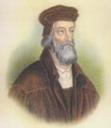
John Wycliffe
John Wycliffe
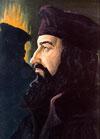
John Hus
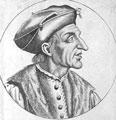
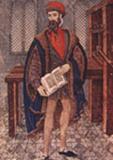
Johann Gutenberg
Thomas Linacre

Erasmus
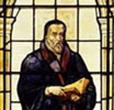
William Tyndale
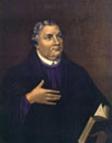
Martin Luther
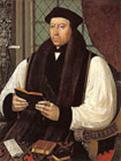
Thomas Cranmer

King Henry VIII











